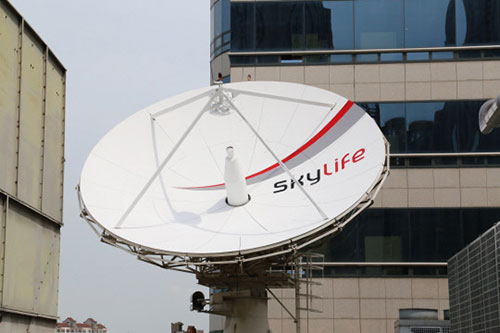Do you know satellite broadcasting without a dish? ‘two way service’ of satellite broadcasting-IPTV combination
Na Won Jae | nwj@ | 2017-03-13 09:18:34

Many people would remember dish-shaped satellite broadcast antennas that were installed on the roof of an apartment veranda or country home a few years ago. The dish-shaped satellite broadcasting antenna has recently been redesigned with DCS (Dish Convergence Solution).
If we think about it, we might have noticed that this dish shaped antenna has gradually disappeared. There have been many stories in this dish antenna.
This is a story of KT Skylife which is the only dish-shaped satellite broadcasting antenna provider in Korea. The company was founded in early March 2002 as a subsidiary of KT mobile- a mobile service operator. The company received the signal from the ‘Mugunghwa’ satellite with the dish antenna and broadcasted it with the digital signal throughout the country.
The Skylife was rated as superior to analog broadcasting at that time. Especially, the cable TV service was not available in the mountain areas, such as a fringe area, but the company was able to easily send a broadcast signal from the sky.
However, broadcasting technology has been developed gradually. In addition to cable TV, Internet TV (IPTV) businesses began to operate based on the Internet Protocol (IP), and the competitiveness of the company began to gradually weaken.
The first change was that the skyscrapers rapidly entered and there was a shaded area. Satellite broadcasting through the satellite at an altitude of 30,600 km has had broad area covering the mountains of the island. However, satellite radio transmission (high-frequency (11 GHz ~ 12 GHz) and the shaded areas have extensively occurred due to special wave straightness.
Besides, Skylife not able to provide two way service, in other word, Video On Demand (VOD) service that can be provided by cable TV and IPTV. Therefore dish antenna was buried in memory with time.
These dish antennas have recently been made to look like DCS, and are getting ready to come back to the world. DCS is a technology that receives the satellite broadcasting signal transmitted from the satellite and then converts it into IP signal and transmits it through the Internet network.
Users, now, do not need to install a dish antenna individually as it is possible to watch satellite broadcasting through the common wired antenna of the apartment. The competition among Cable TV, IPTV and VOD services has begun.
The company has received DCS license from the Ministry of Science, ICT and Future in October of last year and has installed an antenna that receives satellite signals and a modulator that converts satellite signals to IP signals. The company is planning to build DCS networks in five major metropolitan cities such as Daejeon, Daegu, Busan, Gwangju and Ulsan until March, and will start DCS subscriber attraction from April. The company plans to gradually expand it nationwide.
It means that Pay-TV IP is not an option but a necessity now. The company can provide various interactive services such as VOD through DCS. The company currently offers more than 8,000 films and contents including terrestrial, multi-segment, multi-channel (MPP) content providers and content providers (PP).
Currently, users can use about 320 pieces of latest 740 domestic and overseas movies, and about 1900 contents including 8 channels of CJ E & M such as tvN and Mnet which have recently been finalized. In addition, about 3100 films including JTBC, MBN, TV shipbuilding, and current affairs of drama, entertainment program, existing Sky TV contents and 1900 contents for children can be watched.
The company stated that it will launch an internet-based TV (OTT, Over the Top) using its Android application and increase its VOD service based on it.
The company is expected to be able to activate the domestic content market through co-existence of existing content as well as small and medium-sized program providers (PPs), as the foundation for providing interactive services such as VOD for satellite broadcasting through Android TV service and DCS.
On the other hand, paid broadcasting market competition seems to be fiercer in the future based on DCS service.
By Na Won Jae nwj@
